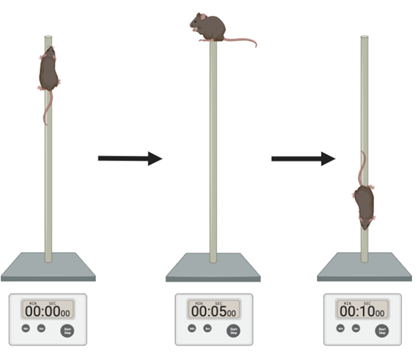The pole test is a common and straightforward test to assess motor coordination in mice. While ataxia might be easy to see in patients, it is not always as apparent in ataxia mouse models. Therefore, this fast and simple test is important for researchers to measure disease severity. It is also important to test the effect of different treatment strategies.

How is the pole test performed?
At the beginning of the test, the mouse is placed facing upward on the top of a long pole. The researchers then measure the time the mouse takes to turn around and climb down to the bottom of the pole. A healthy mouse typically takes 10-20 seconds to perform the task. If the mouse struggles and takes a long time to get to the bottom, it suggests that the mouse has motor coordination deficits.
Researchers commonly use the pole test because it’s a quick way to assess coordination in mice, even before the mice show obvious ataxia symptoms. The pole test takes about 5 minutes per mouse. It is thereby much faster than other motor coordination tests, such as the rotarod test, typically performed over multiple days. Another advantage is that the pole test can be repeated on the same mice multiple times. This allows for tracking how a mouse’s motor coordination changes over time.

How is the pole test used in literature?
One example of the pole test being used in the literature is a study by Nitschke and colleagues. In this study, the researchers identified a small regulatory RNA, miR760, that regulates the levels of ATXN1. ATXN1 is the gene that causes Spinocerebellar Ataxia Type 1 (SCA1). The group showed that injections of miR760 in the brain decreases ATXN1 protein levels in a SCA1 mouse model. The researchers then used the pole test to measure how the treatment with miR760 would affect the ataxia phenotype in the SCA1 model. They found that one month after the treatment the mice displayed improved motor coordination compared to control mice.
If you would like to learn more about the Pole Test, take a look at this resource by Melior Discovery. You can learn more about other motor coordination tests in our past Snapshots on the Rotarod Test.
Snapshot written by Eder Xhako and edited by Dr. Larissa Nitschke.









